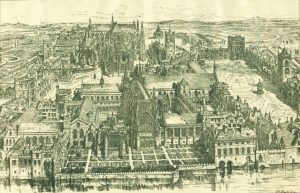



Images: Westminster great hall, great hall ceiling with hammerbeams, and exterior of Westminster great hall (photos C.A. Stanford); conjectural reconstruction of Westminster Palace in the sixteenth century (with abbey in background; Photo courtesy https://upload.wikimedia.org/wikipedia/commons/9/91/Westminster_16C.jpg)
Acquired: 1509 (by inheritance)
At Henry’s accession, Westminster was not only the king’s principal residence, but it was also the legal and administrative center of the kingdom. A fire in 1512, however, damaged the residential portions significantly and the king shifted to other residences in the London area: first Bridewell, and after 1530, York Place (converted to Whitehall Palace, which was conveniently located just to the north of the Westminster complex). Legal and administrative offices continued to be housed at Westminster, however, and portions of the former palace were reconfigured for these purposes (such as St. Stephen’s chapel, which was assigned to the House of Commons the year of Henry’s death). Another fire in 1834 destroyed even more of the old palace, and the site was rebuilt by Barry and Pugin in the Neo-Gothic format that has become an iconic visual symbol for London’s government to this day.
Very little of the old medieval palace, and even less from Henry VIII’s era, survives into modern times. Westminster Hall with its 1393 hammerbeam roof is a rare exception; the timber design, by master carpenter Hugh Herland, proved influential on royal great halls, and provided inspiration for a number of structures in Henrician palaces, the last (and largest) of which was at Hampton Court. The tradition of elaborate waterworks, introduced at medieval Westminster, also likely inspired later royal palace building, as houses like Hampton Court often featured impressive conduits and fountains.
Building at Westminster in Henry’s reign, however, focused on basic repairs, often of roofs (like that of the Great Hall in 1538–40) and the creation of new office quarters for court appointees. Some of the works built at Westminster were temporary, like stands built for the elaborate coronation for Anne Boleyn in 1533; preparations were also begun for a coronation for Jane Seymour in 1537, but were halted due to sickness in the capital (followed by her early death). In Henry’s later years, materials from the old palace of Westminster were also carted away for reuse at neighboring Whitehall, which became Henry’s new chief London palace.
*Click here to see the women vendors that worked at this site.